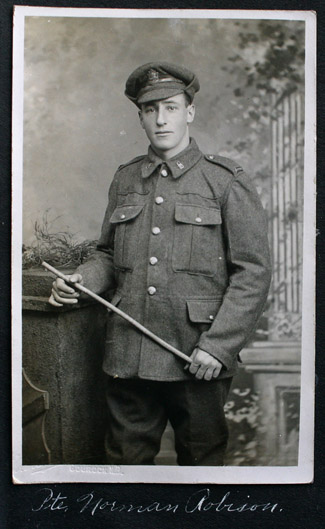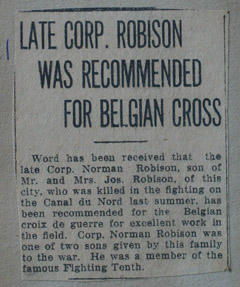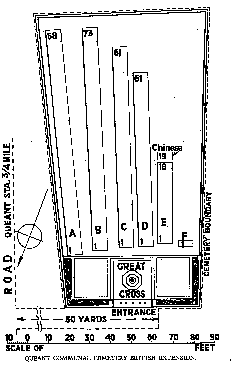

In memory of
Lance Corporal
NORMAN JAMES ROBISON
Service Number: 20813
August 17, 1893 - September 29, 1918
Medium sized pop up image
700 X 1140, 72 dpi, 296 kFull sized pop up image
1138 X 1853, 180 dpi, 1400 k
Undated photograph of Pte. Norman Robison taken between time of enlistment and prior to his promotion to corporal before his death 29 Sep 1918. Source: Tim Patterson, 7 Aug 2008 from the Robison Family photograph collections at Campburn Farm, Harvey Station, York County, New Brunswick.
Military Service
Service Number: 20813Age: 25
Force: Army
Unit: Canadian Infantry (Alberta Regiment)Division: "D" Coy. 10th Bn.
Commemorated on Page 493 of the First World War Book of Remembrance.
Medium sized pop-up image
541 X 695, 96 dpi, 181 kAdditional Information:
Corporal Norman Robison, was the son of George Robison and Margaret "Maggie" Embleton. The family moved to Aerta in 1911, altough all of their children were born in Harvey. Norman Roblson was born 17 Aug 1893, moved to Lethbridge, Alberta with his family when he was 18, and died 29 Sep 1918, WWI, Battle of Canal-du-Nord and Cambrai, France.
Newspaper Obituary
"From undated newspaper clipping:
Late Corp. Robison Was Recommended For Belgium Cross
Word has been received that the late Corp. Norman Robison, son of Mr and Mrs Jos. (sic) Robison, of this city, who was killed in the fighting on the Canal du Nord last summer, has been recommended for the Belgium croix de guerre for excellent work in the field. Corp. Norman Robison was one of two sons given by this family to the war. He was a member of the famous Fighting Tenth."
Medium Sized
Pop-up Image
700 X 837 jpeg;
304 k; 72 dpiFull Sized
Pop-up Image
978 X 1169 jpeg;
1000 k; 180 dpiCemetery:
Queant Communal Cemetery British Extension
Pas de Calais,FranceLocation:
Queant if a village 19 kilometres south-east of Arras. The Cemetery is on the western outskirts of the village on the west side of the road to Raincourt.Queant was close behind the Hindenburg Line, at the South end of a minor defence system known as the Drocourt-Queant Line, and it was not captured by British troops until the 2nd September, 1918. On the North side of the Communal Cemetery was a German Extension of nearly 600 graves (1916-1918), now removed; and the British Extension was made by fighting units, on the far side of the German Extension, in September and October, 1918.
Casualty Details: UK 161, Canada 112, New Zealand 3, Total Burials: 276
Grave Reference:
B. 61
Queant Communal Cemetery
British Extension PlanMedium sized pop-up image
500 X 752, 72 dpi, 18 kCanal-du-Nord and Cambrai: Fall 1918
During the fall of 1918 the focus of Allied objectives was to break through that most formidable of German defensive systems, the Hindenburg Line. The risk of encountering the entire German reserve massed against an Allied onslaught was too great. Instead of trying to focus the Allied effort by attacking the enemy at his strongest point, a new strategy was employed—to utilise the entire front from the Meuse to the English Channel and attack at different points. Canadian forces were to advance toward Cambrai.
Battleground: Canal-du-Nord and Cambrai
Cambrai is situated in the Nord-Pas de Calais region in northern France. It is surrounded by an elaborate system of canals providing links to the Steele and Scheldt rivers to the northeast and drainage of marshy lands. West of Cambrai lies the Canal-du-Nord, whose construction at the outbreak of war had been left incomplete, a serious obstacle to Allied troops advancing from the west. The enemy had flooded the already swampy area and there was only a 4,000-metre southward stretch in which the ground was firm and the Canal-du-Nord (itself 35 metres wide) was dry. If this passage could be crossed, Bourlon Wood and the high ground to the north could be captured. The enemy placed machine-gun posts close to the canal's flanks and other units were locked into natural defences. The main German defences at the Marquion Line were only a mile past the canal. The problem was to quickly move the whole Corps, with heavy artillery, through that narrow defile before the enemy attacked.
The Plan: A Two-Division, Three-Brigade Attack
The Canadian Corps, under General Sir Arthur Currie, was put in charge of operations conceived as a set-piece attack. Because of the extremely narrow divide, at zero hour on September 27, the battlefront presented only two brigades on the left and one on the right, with a creeping artillery barrage and sappers following over hastily-built bridges, pontoons and cork slabs baled with wire netting. One artillery subsection supported each divisional artillery section behind the front line.
Once across the canal, troops would reassemble and the front had to be widened at lightning speed from 2,600 metres to 15,000 metres in order to circle Bourlon Wood, capture the Blue Line and prepare to press forward toward Cambrai. In 12 hours of fighting, the Canadians covered approximately 8,500 metres of ground with the 4th Division's 38th, 87th and 102nd Battalions arriving first and the 1st Division's 1st and 13th Battalions following with greater difficulty. In the following four days of difficult fighting, both divisions, along with reinforcements from the 3rd Division, managed to secure only a limited amount of territory and by October 1, exhausted troops were ordered to rest and reassemble. Operations to capture Cambrai and secure ground northeast of the city resumed on October 8, mainly involving in the 2nd and 3rd Divisions and lasting a total of four days.
Map showing position of Canadian Corps units during the Battle of Canal Du Nord and Cambrai, 27 Sep - 11 Oct 1918. Annotation on map shows where Norman Robison of the "Fighting 10th" Battalion was killed in action on 29 Sep 1918.
Map courtesy Directorate of History and Heritage, National Defence Headquarters, Ottawa.
Medium Sized
Pop-up Image
1300 X 821 jpeg;
600 k; 72 dpiFull Sized
Pop-up Image
5381 X 3400 jpeg;
10,000 k; 600 dpi
The Keys: Artillery, Engineers, Tanks and Communications
If the infantry undertook this delicate mission, it absolutely needed finely-tuned support from other divisional and corps troops. First, groups of artillery field brigades would relay each other in a continuous rolling barrage to support the infantry as it progressed through the Red, Green and Blue Lines, and as it fought a stiff battle onto Cambrai. Second, the engineer brigades were rapidly deployed, often working under machine gun fire to make the canals passable by building vital bridges and pontoons for artillery troops and floating foot bridges over water-tilled portions of the canal. Third, British 7th Battalion tanks were deployed en masse (four tanks per attacking infantry brigade) to fire, crush wires and create smoke screens from their exhaust pipes. Many war diarists note the invaluable service the tanks provided. Finally, without accurate communications to coordinate infantry and artillery advances, the operation's success could at best be limited. For example, if an infantry battalion advanced beyond its objective, but if the support artillery behind it remained without accurate information on its position, the results could be disastrous.
Battle Objectives: Red, Green and Blue Lines; Fighting towards Cambrai; Capture of Cambrai
British and Canadian military leaders puzzled long and hard over which course to take through the almost impassable marshland and a system of canals over which the enemy had an almost uninterrupted view from the higher ground beyond. The objective was for the 1st and 4th Divisions to quickly cross the Canal-du-Nord, take Bourlon Wood, and capture surrounding towns, pushing to the northeast. Then the 3rd Division would join them and push to the Cambrai/Douai Road opposite Tilloy. The 3rd and 4th Divisions would seize bridgeheads over the Canal de l'Escaut at Ramillies and Eswars, northeast of Cambrai, after which the 1st Division was to pass through their ranks to capture Abancourt east of the Douai Railway pushing on to Fressies at the Sensée Canal. The 2nd Division would then take its turn for the heart of the operation to capture Cambrai by forcing a passage over the Canal de l'Escaut between Morenchies and Ramillies and establishing a line on high ground behind Escaudoeuvres, "joining hands" with the British positioned there. Combined troops would then cross the canal and establish bridgeheads at Cambrai, clear the city and open the front eastward. Finally, ground northeast of Cambrai on both sides of the Canal de l'Escaut had to be cleared up to Iwuy.
Preparations
For the Canal-du-Nord and Cambrai offensives, the strength of the Canadian Corps, including attached troops, stood at 118,194 men. Of the 98,790 Canadians in this Corps, direct assault troops accounted for less than half of combatants. This meant that a great portion of the Corps was involved in preparations. Engineers, signal troops, transport and labour companies, and medical and veterinary units were all heavily involved in building bridges, relaying vital intelligence, constructing and repairing railway and communication lines, delivering supplies, caring for the wounded and maintaining horses. Under heavy attack not only from shells, but also machine-gun fire, they unfailingly carried out their work.The Attack
5:20 a.m. (zero hour) on September 27. An artillery barrage exploded over enemy positions and
the 1st Division began to move swiftly. Successfully crossing the dry bed of the Canal-du-Nord as dawn broke, the Canadians rapidly secured the Green Line. Passing through their ranks, the 4th Division gained entry into the southern part of Bourlon Village around 9:45 a.m., but not without heavy casualties. By 2:00 p.m., they passed the Blue Line and attained the objective of capturing Bourlon Wood (Blue Line). Pushing on, by the end of the afternoon, while the 15th Infantry Brigade stood firm at the Blue Line, brigades from the 1st and 4th Canadian Division, plus the British 11th Division, cleared the enemy's Marcoing trench system. Victory was assured by 8:00 p.m. as the last pocket of enemy resistance is overcome.Success: lst Division (Major-General MacDonell) and 4th Division (Major-General Watson), September 27, 1918
Setback: 1st Division, 3rd Division (Major-General Loomis ) and 4th Division, September 28-October 1. The first day's resounding success is mitigated by the setbacks of the ensuing four days. Having brilliantly met the first objective of the battle, the 1st and 4th Divisions prepared to press eastward to Cambrai along with the 3rd Division. They ran into unmapped wire and suffered heavy losses in front of the Douai Road, making progress only slowly and painfully to their intermediate objective of seizing bridges over the Canal de l'Escaut and establishing a united front across to the Canal de la Sensée. Before attempting to draw in on Cambrai, exhausted troops were forced to pause and reorganize.Success: 2nd Division (Major-General Burstall) and 3rd Division, October 8-9. Attacking alone at 1:30 a.m. on October 8, after failing to make contact with British troops, the Canadian 2nd Division crossed a hastily-constructed bridge over the Canal de l'Escaut, successfully attaining the objective of forcing that passage. The 3rd Division established a line of posts on the eastern outskirts of Cambrai, and finally, the British moved up and joined with the 2nd Division northeast of Cambrai, as planned.
Setbacks for the 2nd Division in ending of the battle. In spite of its ultimate success, several incidents plagued the 2nd Division as it continued its advance beyond Cambrai. As it began to clear northeast of the city, it comes under heavy enemy fire and has to dig in. The Canadian Light Horse, also pushing ahead to secure the surrounding areas, falls into machine-gun fire at Iwuy and Naves. This causes heavy casualties to men and horses. Nevertheless, with Cambrai successfully captured and secured, at 5:00 p.m. on October 11, General Currie handed over the commands to the British 22nd Corps. The battle was over. Of the 68,500 men engaged in the conflict, 13,672 or 20 percent were lost in the Canal-du-Nord and Cambrai operations.
Source:
Veterans Affairs CanadaEntry last updated 2 November 2008
Please contact Tim Patterson (tim.patterson@carleton.ca)
to provide additional data, or to correct any errors.





